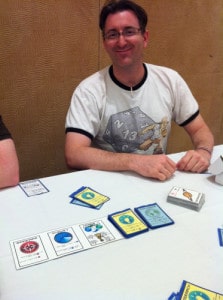
Things go wrong in playtests all the time. When something goes wrong in a playtest, it may just be an anomaly of that particular game — but if the same thing comes up in multiple plays, then it’s probably indicative of some kind of problem with the design. As designers, it’s our job to identify these problems and fix them.
This may be harder than it sounds though. Sometimes the issue experienced in a playtest is merely a symptom of a deeper problem. While it may be worthwhile to fix the symptom, what we really want to do is determine the underlying problem and fix that, or else another symptom is likely to rear its ugly head before long.
By way of example I’ll illustrate what I mean:
When I was originally testing Eminent Domain, instead of the 5 different role cards in the game there were 6. Produce and Trade were separate cards, not combined into one card. Produce/Trade cycles had the potential to be more lucrative than other scoring paths, but the logistics behind having to take the two separate roles, and having cards for each in your deck, were supposed to balance that out. However, in practice I found that Produce/Trade strategies were frustrating to pursue because it was hard to score well off of the cycle. So hard in fact that players would ignore that strategy altogether.

At first I tried doubling the value of a Produce/Trade cycle, thinking that with higher rewards, players would pursue the strategy. In theory that worked, I could keep increasing the value of trading until it was worth going for. But that solution treated the symptom, not the problem. The more valuable I made trading, the more variable and swingy that strategy (and the game) would become… a player trying to produce and trade might never get their cards in the right order, and when they did they’d get a disproportionately high reward, like a slot machine. The real problem here was that it sucked to have to fill your deck with 2 different cards that were terrible on their own just so that MAYBE you can use them to collect lots of points.
Fortunately one of my players (thanks Wystan!) suggested putting both roles on the same card so that whenever you draw that card, it’d work for either the Produce role or the Trade role – whichever you need at the time. This solution ignored the symptom and went straight for the throat of the underlying problem. As soon as I tried it I immediately knew it was the right solution. And as a result of solving the problem, it eliminated the symptom as well.

So let that be a lesson to you. When something goes wrong in your playtests, don’t take it at face value. Make sure to look and see if the issue is merely a symptom of a bigger problem, then do what you can to fix the underlying problem.








